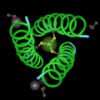Modified from the original post.
 Playing around with molecular structures is one of the more entertaining activities that you can do with digital biology. I've become totally entranced with molecular structures, both because they're a fascinating art form and because every structure has its own story.
Playing around with molecular structures is one of the more entertaining activities that you can do with digital biology. I've become totally entranced with molecular structures, both because they're a fascinating art form and because every structure has its own story.
I learned this because I ended up writing 69 different structure stories for the "Exploring DNA Structure" instructor guide. This was never in my original plan but my friend Charlotte Mulvihill wrote to ask me about the functions of different structures. I blithely replied that sometimes the only function was to satisfy the curiosity of the researchers. Then, I started to wonder, too, and couldn't help reading about all of them and compiling an answer guide for the manual.
The more I learned, the more fascinated I became. Some of my favorite DNA structures are below the fold.
 I put several structures on the Exploring DNA Structure CD that contain anti-cancer or antiviral drugs bound to DNA. These drugs kill cancer cells by making it hard for cells to copy, unwind, or repair their DNA. Although these drugs harm all growing cells, cancer cells suffer the most damge since they grow more rapidly than normal cells. This image shows tamoxifen, a drug that's used to treat both breast and lung cancer, bound to DNA.
I put several structures on the Exploring DNA Structure CD that contain anti-cancer or antiviral drugs bound to DNA. These drugs kill cancer cells by making it hard for cells to copy, unwind, or repair their DNA. Although these drugs harm all growing cells, cancer cells suffer the most damge since they grow more rapidly than normal cells. This image shows tamoxifen, a drug that's used to treat both breast and lung cancer, bound to DNA.
 Telomeres protect the ends of linear, eucaryotic chromosomes. Unlike the rest of the chromosome, with double-stranded or duplex DNA, telomeres form four-stranded quadruplex structures with lots of positively charged ions. I think the ions probably shield the negatively charged phosphates and allow the strands to get close together.
Telomeres protect the ends of linear, eucaryotic chromosomes. Unlike the rest of the chromosome, with double-stranded or duplex DNA, telomeres form four-stranded quadruplex structures with lots of positively charged ions. I think the ions probably shield the negatively charged phosphates and allow the strands to get close together.
 DNA can form interesting loop structures where a single-strand kind of twists around back on itself. This structure is thought to regulate expression of the protective antigen gene, in Bacillus anthracis, the bacteria that cause antrax. The protective antigen plays a key role in development of anthrax symptoms. If we can understand how this gene is turned on or off, perhaps we can find a way to turn this gene off and prevent the symptoms altogether.
DNA can form interesting loop structures where a single-strand kind of twists around back on itself. This structure is thought to regulate expression of the protective antigen gene, in Bacillus anthracis, the bacteria that cause antrax. The protective antigen plays a key role in development of anthrax symptoms. If we can understand how this gene is turned on or off, perhaps we can find a way to turn this gene off and prevent the symptoms altogether.
 Recombination intermediates, also known as Holliday structures, are wild. When I was an undergraduate, I found recombination to be very mysterious. This structure shows DNA in the act of breaking and joining to other strands. DNA is busily breaking and joining when your egg or sperm cells are getting made.
Recombination intermediates, also known as Holliday structures, are wild. When I was an undergraduate, I found recombination to be very mysterious. This structure shows DNA in the act of breaking and joining to other strands. DNA is busily breaking and joining when your egg or sperm cells are getting made.
technorati tags: biology, molecular models, DNA structures, DNA, bioinformatics, Cn3D

We might be plesantly surprised one day while playing around with molecular structes and discover a solution to other physical or psychological diseases, chronic symptoms or otherwise. Play on!